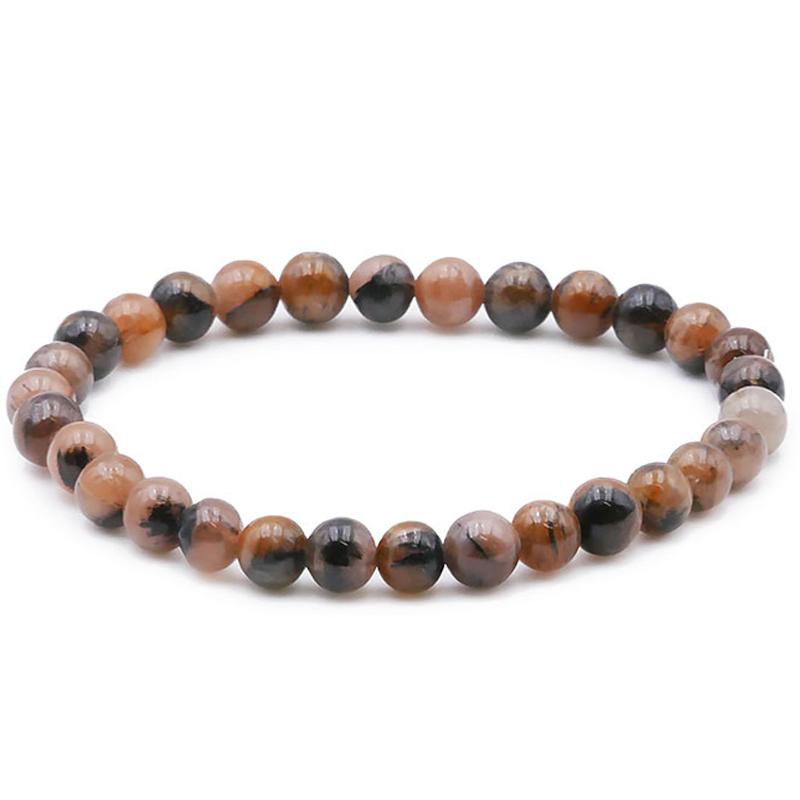China AA chiastolite bracelet (5-6mm balls)
BRA-CHIA-02
- Regular price
-
32,90 € - Regular price
-
32,90 € - Sale price
-
32,90 €
Couldn't load pickup availability
Learn more
BRA-CHIA-02
Origin: China
Grade: AA
Dimensions:
Approximately 18cm - Fits all wrists from 17 to 19cm
Weight:
About 15g
Bracelet made of 5-6mm chiastolite balls.
Patterns and colors may vary from one bracelet to another
The name chiastolite comes from the ancient Greek “kiastos” meaning “marked with a cross” and is pronounced “kiastolite”. However, according to other sources, it is said that chiastolite owes its name to the Latin “macula”, a term which translates as “spot”. This stone is also called “cross stone” or “andalusite” because of its appearance.
In fact, chiastolite is one of the most widespread species of andalusites. It is notable for its dark color, in an orange-brown crystal, and its cross, formed by inclusions of carbon and clay, hence its Greek etymology.
During archaeological excavations on the Iberian Peninsula, remains of chiastolite were discovered. This suggests that this stone has been used for millennia. In the 18th century, this stone was described by José Torrubia, a Spanish Jesuit naturalist in his encyclopedia. Furthermore, it is found in quantity in the north of Spain. José Torrubia then recounts that until the end of the 16th century, this stone was used as an amulet by pilgrims on the paths to Santiago de Compostela. In the past, chiastolite was known to ward off curses.
In Chile, chiastolite is the origin of various myths among the Mapuche Indians (meaning “People of the Earth”). This people of warriors violently defended themselves during the attacks of the Incas, then against those of the Spanish conquistadors. They wanted to capture them in order to make them their slaves. A chiastolite was attributed to the soul of each warrior killed by the Spanish.
During this battle, a young Spanish girl was captured by the Indians, who treated her with respect. Once at the camp, she learned to respect the customs of her captors, then to appreciate them. As time passed, the girl fell in love with a warrior of the tribe. They wanted to get married but the whole tribe was opposed to this union.
Returning to camp after a battle, the young warrior was kidnapped by members of his tribe and held prisoner in a cave. The young Spaniard was then told of his death and that the body of her beloved was lying in the forest. She, desperate and crying all the tears in her body, went looking for him.
It is said that the young girl's tears were transformed into chiastolite by the goddess Pachamama (goddess of Mother Earth), who was touched by her despair. This goddess is an important protective deity. It represents fertility, abundance, femininity and generosity. Then this miracle moved the rest of the tribe and a shaman was called to find out what Pachamama wanted. She ordered the two lovers to be reunited and let them get married. Thus, they could live their love in peace.
In 1798, Jean-Claude Delametherie (1743-1817), a French naturalist, mineralogist and geologist, precisely described samples from Spain, which he named andalusite and chiastolite respectively. He was convinced that these samples were from Andalusia, when in fact they had been found in Castile and had nothing to do with Andalusia.
Chiastolite belongs to the silicate group. It is essentially made up of silicon dioxide, metal oxides such as aluminum, magnesium or sodium. It has a hardness of 7.5 on the Mohs scale, and also offers great thermal resistance. Thanks to this property, this stone is frequently found in the metallurgy industries.
The main deposits are in China, Australia, Canada, Belgium, France, Russia, etc.
The chiastolite stone facilitates introspection and helps to discover the blockages at the origin of our fears, sometimes buried since birth. It allows you to have good self-knowledge.
During changes in life, it helps to make the right decisions and to look forward to the future with complete peace of mind. It removes fears, which can be an obstacle to personal development. It helps you make difficult choices.
It is known to soothe and calm the nerves. It relieves nervous tension caused by stress, alleviating contractures and muscle cramps. It has regenerative virtues which promote recovery during severe physical and psychological fatigue.
This stone is a soothing stone, which regulates emotional excesses. It provides balance between various emotions. It calms fears, wards off anxieties and negative feelings.
A magnificent stone of harmony, chiastolite balances emotions and removes feelings of guilt. It gives self-confidence and offers great assurance. Thus, it provides serenity, allowing one to overcome the difficulties of life.


China AA chiastolite bracelet (5-6mm balls)
- Regular price
-
32,90 € - Regular price
-
32,90 € - Sale price
-
32,90 €
-
100% SECURE PAYMENT
Paypal, credit card, check, transfer
-
FREE DELIVERY
from 40€ purchase
-
SATISFIED OR REFUNDED
14 days to change your mind
-
CUSTOMER SERVICE AVAILABLE
contact@laboiteacailloux.com
to receive all our offers, good deals and new products from La Boite à Cailloux


